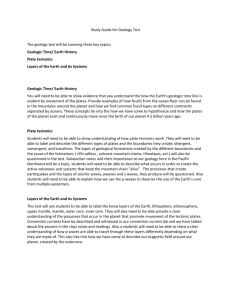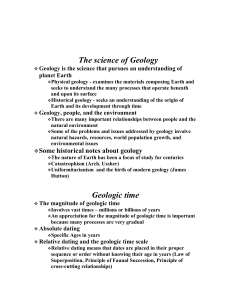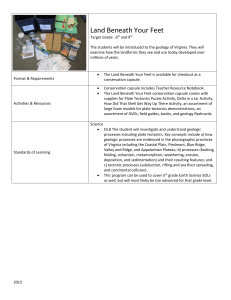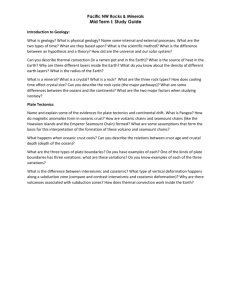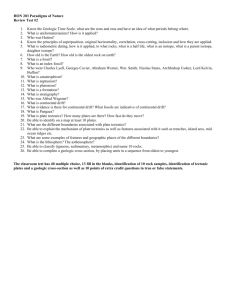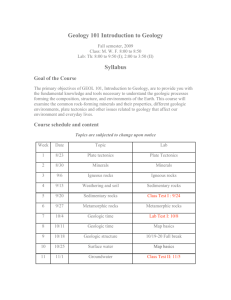Historical Geology
advertisement
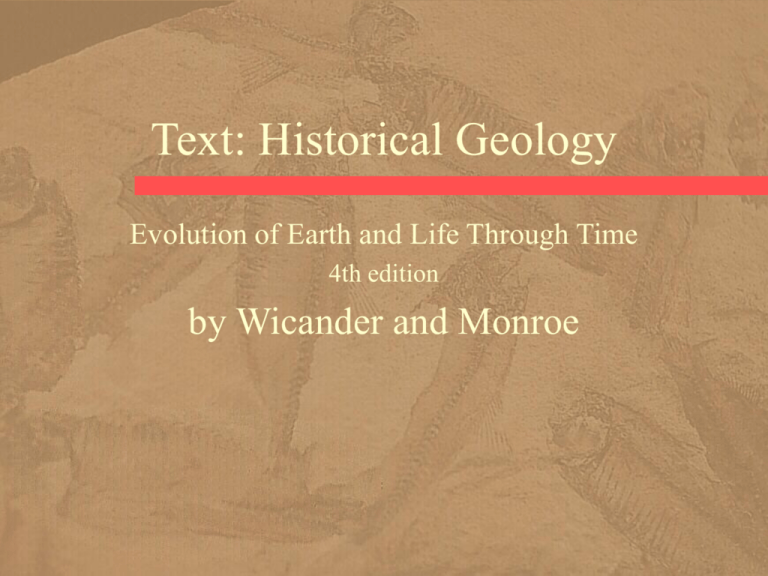
Text: Historical Geology Evolution of Earth and Life Through Time 4th edition by Wicander and Monroe Chapter 1 The Dynamic and Evolving Earth …a brief overview of the semester….refresher from last semester…. -Big Bang origin of universe! -the Scientific Method -Geologic Time -Evolution -Plate Tectonics - Summary of development of Life through Geologic Time…. trilobites to dinosaurs to birds to horses to apes to Modern Man… Historical Geology • Learn to tell time using different clock.. – The Geologic Time Scale… • View geology in 3 dimensions. • Focus on semester, last ¾ , will be on changes in both the surface of Earth and life that existed on it…: • The first is that Earth’s outermost part – is composed of a series of moving plates • Plate tectonics – whose interactions have affected its physical and biological history • The second is that Earth’s biota – has evolved or changed throughout its history • organic evolution This class is about historical geology What is Geology? • From the Greek – geo (Earth) logos (reason) • Geology is the study of Earth • Physical geology studies Earth materials, – such as minerals and rocks – as well as the processes operating within – and on Earth’s surface Historical Geology • In historical geology we study – changes in our dynamic planet – how and why past events happened – implication for today’s global ecosystems • Principles of historical geology – not only aid in interpreting Earth’s history – but also have practical applications • William Smith, an English surveyor/engineer – used study of rock sequences – to help predict the difficulty of excavation – in constructing canals Scientific Method • The scientific method – an orderly and logical approach – Gather and analyze facts or data • 1. A hypothesis is a tentative explanation – to explain observed phenomena – 2. Gather and analyze facts or data • Scientists make predictions using hypotheses -3. then they test the predictions • After repeated tests, make 4. Conclusion – if one hypothesis continues – to explain the phenomena, – scientists propose it as a theory Origin of the Universe • The Big Bang – occurred 15 billion years ago – and is a model for the beginning of the universe – Age of Earth: 4.5 Billion years Solar System Configuration Houston Chronicle- August 16, 2006 Earth’s Interior Layers • Crust - 5-90 km thick – continental and oceanic • Mantle – composed largely of peridotite – dark, dense igneous rock – rich in iron and magnesium • Core – iron and a small amount of nickel Plate Tectonic Theory • Lithosphere is broken into individual pieces called plates • Plates move over the asthenosphere – as a result of underlying convection cells Modern Plate Map Central Thesis of Evolution • All present-day organisms – are related – and descended from organisms – that lived during the past • Natural selection is the mechanism – that accounts for evolution • Natural selection results in the survival – to reproductive age of those organisms – best adapted to their environment History of Life • The fossil record provides perhaps – the most compelling evidence – in favor of evolution • Fossils are the remains or traces – of once-living organisms • Fossils demonstrate that Earth – has a history of life Geologic Time Scale Summary • Earth is a system – of interconnected subsystems • Geology is the study of Earth • Historical geology is the study – of the origin and evolution of Earth • Scientific method is – – – – an orderly, logical approach to explain phenomena, using data, formulating and testing hypotheses and theories • Universe began with – a big bang 15 billion years ago Summary • Solar system formed 4.6 billion years ago – by condensation and gravitational collapse – of a rotating interstellar cloud • Earth formed 4.6 billion years ago – as a swirling eddy in the solar system nebula • Moon may have formed – when a planetesimal collided with Earth – 4.6 to 4.4 billion years ago • Earth probably started solid – then differentiated into layers – as it heated and melted Evidence for the Big Bang • Universe is expanding • How do we determine the age? – measure the rate of expansion – backtrack to a time when the galaxies – were all together at a single point • Pervasive background radiation of 2.7º above absolute zero – is the afterglow of the Big Bang Origin of Our Solar System Solar nebula theory • cloud of gases and dust • formed a rotating disk • condensed and collapsed due to gravity • forming solar nebula – with an embryonic Sun – surrounded by a rotating cloud Earth’s Differentiation • Differentiation = segregated into layers of differing composition and density • Early Earth was probably uniform • Molten iron and nickel sank to form the core • Lighter silicates flowed up to form mantle and crust Earth’s Interior Layers • Crust - 5-90 km thick – continental and oceanic • Lithosphere – solid upper mantle and crust • Mantle – composed largely of peridotite – dark, dense igneous rock – rich in iron and magnesium • Core – iron and a small amount of nickel • Asthenosphere – part of upper mantle – behaves plastically and slowly flows Earth’s Interior Layers • Lithosphere – solid upper mantle and crust – broken into plates that move over the asthenosphere • Asthenosphere – part of upper mantle – behaves plastically and slowly flows Earth’s Crust • outermost layer • continental (20-90 km thick) – density 2.7 g/cm3 – contains Si, Al – granite • oceanic (5-10 km thick) – density 3.0 g/cm3 – composed of basalt Plate Tectonic Theory • At plate boundaries – Volcanic activity occurs – Earthquakes occur • Movement at plate boundaries – plates diverge – plates converge – plates slide sideways past each other Plate Tectonic Theory • Types of plate boundaries Divergent Mid-oceanic plate ridge boundary Transform plate boundary Continentalcontinental convergent plate boundary Continentaloceanic convergent plate boundary Divergent plate boundary Trench Oceanicoceanic convergent plate boundary Plate Tectonic Theory Influence on geological sciences: • Revolutionary concept – major milestone • comparable to Darwin’s theory of evolution in biology • Provides a framework for – interpreting many aspects of Earth on a global scale – relating many seemingly unrelated phenomena – interpreting Earth history Theory of Organic Evolution • Provides a framework – for understanding the history of life • Darwin’s – On the Origin of Species by Means of Natural Selection, published in 1859, – revolutionized biology Geologic Time • From the human perspective time units are in – seconds, hours, days, years • Ancient human history – hundreds or even thousands of years • Geologic history – millions, hundreds of millions, billions of years Geologic Time Scale • Resulted from the work of many 19th century geologists who – – – – pieced together information from numerous rock exposures, constructed a sequential chronology based on changes in Earth’s biota through time • The time scale was subsequently dated in years – using radiometric dating techniques Uniformitarianism • Uniformitarianism is a cornerstone of geology – is based on the premise that present-day processes – have operated throughout geologic time • The physical and chemical laws of nature – have remained the same through time • To interpret geologic events – from evidence preserved in rocks – we must first understand present-day processes – and their results • Rates and intensities of geologic processes – may have changed with time Principle of Horizontality • Illustration of the principles of superposition – and original horizontality • Horizontality: These sediments were originally – deposited horizontally – in a marine environment – This outcrop is Chattanooga Shale, Tennessee Principle of Superposition • Illustration of the principles of superposition – and original horizontality • Superposition: The youngest – rocks are at the top – of the outcrop – and the oldest rocks are at the bottom How Does the Study of Historical Geology Benefit Us? • Survival of the human species – depends on understanding – how Earth’s various subsystems – work and interact • Study what has happened in the past, – on a global scale, – to try and determine how our actions – might affect the balance of subsystems in the future We “Live” Geology • Recent events in Indian Ocean area and southern California demonstrate that….. • Our standard of living depends directly on – our consumption of natural resources – resources that formed millions and billions of years ago • How we consume natural resources – and interact with the environment determines – our ability to pass on this standard of living – to the next generation Summary • Earth’s layers mostly solidified – – – – into the core, mantle and crust, with the upper mantle and crust making up the soft asthenosphere and the solid lithosphere • Lithosphere is broken into plates – that diverge, converge and – slide sideways past each other • Plate tectonics is a unifying theory – that helps explain features and events – including volcanic eruptions, – earthquakes and mountain forming Summary • Central thesis of organic evolution is – that all living organisms evolved – from organisms that existed in the past • An appreciation – of the immensity of geologic time – is central to understanding Earth’s evolution • Uniformitarianism holds that the laws – of nature have been constant through time • Geology is part of our lives – and our standard of living depends – on our use of natural resources – that formed over billions of years Text: Historical Geology Evolution of Earth and Life Through Time 4th edition by Wicander and Monroe The Movie of Earth’s History • What kind of movie would we see – if it were possible to travel back in time – and film Earth’s History – from its beginning 4.6 billion years ago? • It would certainly be a story of epic proportions – – – – with great special effect and a cast of trillions twists and turns in its plot with an unknown ending • Although we cannot travel back in time, – the Earth’s History is still preserved – in the geologic record Subplot: Landscape History • In this movie we would see – – – – – a planet undergoing remarkable change as continents moved about ocean basins opened mountain ranges grew along continental margins and where continents collided – – – – form and grow change circulation patterns cause massive ice sheets to form and grow and then melt away • The oceans and atmosphere would • Extensive swamps or vast interior deserts – would sweep across the landscape Subplot: Life’s History • We would also witness – the first living cells evolving – from a primordial organic soup – between 4.6 and 3.6 billion years ago • Cell nuclei would evolve, – then multicelled soft-bodied animals – followed by animals with skeletons and then backbones • The barren landscape would come to life as – plants and animals moved from their watery home – insects, amphibians, reptiles, birds and mammals – would eventually evolve Earth is a Dynamic and Evolving Planet • Changes in its surface • Changes in life At the End of the Movie • The movie’s final image is of Earth, – a shimmering blue-green oasis – in the black void of space – and a voice says, • “To be continued.” Solid Earth Plate tectonics is driven by convection in the mantle and in turn drives mountain building and associated igneous and metamorphic activity Atmosphere Plate Tectonics and Earth Systems Arrangement of continents affects solar heating and cooling, and thus winds and weather systems Rapid plate spreading and hot-spot activity may release volcanic carbon dioxide and affect global climate Biosphere Hydrosphere Plate Tectonics and Earth Systems Continental arrangement affects ocean currents Rate of spreading affects volume of mid-oceanic ridges and hence sea level Placement of continents may contribute to the onset of ice ages Movement of continents creates corridors or barriers to migration, the creation of ecological niches, and transport of habitats into more or less favorable climates Big Bang Model • Initial state: – No time, matter or space existed • There is no “before the Big Bang” – Universe consisted of pure energy • During 1st second: – Very dense matter came into existence – The four basic forces separated • gravity, electromagnetic force, 2 nuclear forces – Enormous expansion occurred Big Bang Model (cont.) • 300,000 years later: – atoms of hydrogen and helium formed – light (photons) burst forth for the first time • During the next 200 million years: – – – – Continued expansion and cooling Stars and galaxies began to form Elements heavier than hydrogen and helium began to form within stars by nuclear fusion Features of Our Solar System • • • • • In a spiral arm of the Milky Way Galaxy Sun 9 planets 101 known moons (satellites) a tremendous number of asteroids – most orbit the Sun between the orbits of Mars and Jupiter • millions of comets and meteorites • interplanetary dust and gases Relative Sizes of the Sun and Planets
